Byzantine Art Seated Dog Byzantine Art Seated Dog Mosaic Wiki
Byzantine art comprises the body of Christian Greek artistic products of the Eastern Roman (Byzantine) Empire,[one] equally well equally the nations and states that inherited culturally from the empire. Though the empire itself emerged from the reject of Rome and lasted until the Fall of Constantinople in 1453,[ii] the start date of the Byzantine period is rather clearer in art history than in political history, if yet imprecise. Many Eastern Orthodox states in Eastern Europe, as well as to some degree the Islamic states of the eastern Mediterranean, preserved many aspects of the empire's culture and art for centuries subsequently.
A number of contemporary states with the Byzantine Empire were culturally influenced by information technology without actually being part of information technology (the "Byzantine commonwealth"). These included the Rus, too as some non-Orthodox states similar the Republic of Venice, which separated from the Byzantine Empire in the tenth century, and the Kingdom of Sicily, which had close ties to the Byzantine Empire and had also been a Byzantine territory until the 10th century with a large Greek-speaking population persisting into the 12th century. Other states having a Byzantine artistic tradition, had oscillated throughout the Middle Ages betwixt being function of the Byzantine Empire and having periods of independence, such as Serbia and Bulgaria. After the fall of the Byzantine capital of Constantinople in 1453, fine art produced by Eastern Orthodox Christians living in the Ottoman Empire was often called "post-Byzantine." Certain artistic traditions that originated in the Byzantine Empire, particularly in regard to icon painting and church building compages, are maintained in Greece, Republic of cyprus, Serbia, Bulgaria, Romania, Russia and other Eastern Orthodox countries to the present day.
Introduction [edit]

Byzantine fine art originated and evolved from the Christianized Greek culture of the Eastern Roman Empire; content from both Christianity and classical Greek mythology were artistically expressed through Hellenistic modes of style and iconography.[three] The art of Byzantium never lost sight of its classical heritage; the Byzantine majuscule, Constantinople, was adorned with a large number of classical sculptures,[iv] although they somewhen became an object of some puzzlement for its inhabitants[5] (still, Byzantine beholders showed no signs of puzzlement towards other forms of classical media such every bit wall paintings[six]). The basis of Byzantine art is a central artistic attitude held by the Byzantine Greeks who, like their ancient Greek predecessors, "were never satisfied with a play of forms lone, but stimulated by an innate rationalism, endowed forms with life past associating them with a meaningful content."[7] Although the art produced in the Byzantine Empire was marked past periodic revivals of a classical aesthetic, information technology was higher up all marked by the development of a new aesthetic defined by its salient "abstract", or anti-naturalistic character. If classical fine art was marked by the attempt to create representations that mimicked reality equally closely as possible, Byzantine art seems to accept abandoned this attempt in favor of a more symbolic approach.
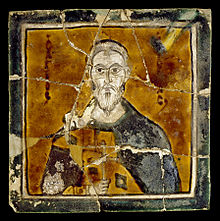
The Ethiopian Saint Arethas depicted in traditional Byzantine style (10th century)
The nature and causes of this transformation, which largely took place during late antiquity, have been a subject of scholarly debate for centuries.[8] Giorgio Vasari attributed information technology to a decline in artistic skills and standards, which had in plow been revived by his contemporaries in the Italian Renaissance. Although this point of view has been occasionally revived, most notably by Bernard Berenson,[9] modernistic scholars tend to take a more positive view of the Byzantine aesthetic. Alois Riegl and Josef Strzygowski, writing in the early 20th century, were above all responsible for the revaluation of belatedly antiquarian fine art.[10] Riegl saw information technology every bit a natural development of pre-existing tendencies in Roman art, whereas Strzygowski viewed it as a product of "oriental" influences. Notable recent contributions to the debate include those of Ernst Kitzinger,[11] who traced a "dialectic" between "abstruse" and "Hellenistic" tendencies in late artifact, and John Onians,[12] who saw an "increase in visual response" in late antiquity, through which a viewer "could look at something which was in twentieth-century terms purely abstract and find it representational."
In any case, the fence is purely modernistic: information technology is clear that virtually Byzantine viewers did non consider their art to be abstract or unnaturalistic. As Cyril Mango has observed, "our own appreciation of Byzantine art stems largely from the fact that this fine art is non naturalistic; notwithstanding the Byzantines themselves, judging by their extant statements, regarded it as being highly naturalistic and as being direct in the tradition of Phidias, Apelles, and Zeuxis."[13]
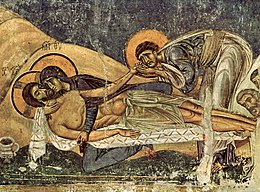
Frescoes in Nerezi about Skopje (1164), with their unique alloy of high tragedy, gentle humanity, and homespun realism, anticipate the approach of Giotto and other proto-Renaissance Italian artists.
The discipline matter of monumental Byzantine art was primarily religious and majestic: the two themes are often combined, as in the portraits of subsequently Byzantine emperors that decorated the interior of the 6th-century church of Hagia Sophia in Constantinople. These preoccupations are partly a issue of the pious and autocratic nature of Byzantine society, and partly a result of its economic structure: the wealth of the empire was full-bodied in the hands of the church building and the purple office, which had the greatest opportunity to undertake monumental artistic commissions.
Religious art was not, however, limited to the awe-inspiring ornamentation of church interiors. One of the most important genres of Byzantine fine art was the icon, an image of Christ, the Virgin, or a saint, used as an object of veneration in Orthodox churches and private homes alike. Icons were more religious than aesthetic in nature: especially later the finish of iconoclasm, they were understood to manifest the unique "presence" of the figure depicted by ways of a "likeness" to that figure maintained through carefully maintained canons of representation.[xiv]
The illumination of manuscripts was some other major genre of Byzantine art. The nearly normally illustrated texts were religious, both scripture itself (particularly the Psalms) and devotional or theological texts (such equally the Ladder of Divine Ascent of John Climacus or the homilies of Gregory of Nazianzus). Secular texts were also illuminated: important examples include the Alexander Romance and the history of John Skylitzes.
The Byzantines inherited the Early Christian distrust of monumental sculpture in religious art, and produced only reliefs, of which very few survivals are annihilation like life-size, in sharp contrast to the medieval art of the West, where monumental sculpture revived from Carolingian art onwards. Small ivories were likewise mostly in relief.
The and then-chosen "minor arts" were very important in Byzantine art and luxury items, including ivories carved in relief every bit formal presentation Consular diptychs or caskets such as the Veroli casket, hardstone carvings, enamels, drinking glass, jewelry, metalwork, and figured silks were produced in big quantities throughout the Byzantine era. Many of these were religious in nature, although a big number of objects with secular or non-representational decoration were produced: for example, ivories representing themes from classical mythology. Byzantine ceramics were relatively crude, equally pottery was never used at the tables of the rich, who ate off Byzantine silver.
Periods [edit]

Byzantine art and architecture is divided into four periods by convention: the Early period, commencing with the Edict of Milan (when Christian worship was legitimized) and the transfer of the imperial seat to Constantinople, extends to AD 842, with the conclusion of Iconoclasm; the Eye, or high period, begins with the restoration of the icons in 843 and culminates in the Fall of Constantinople to the Crusaders in 1204; the Tardily period includes the eclectic osmosis between Western European and traditional Byzantine elements in art and compages, and ends with the Autumn of Constantinople to the Ottoman Turks in 1453. The term mail-Byzantine is then used for later on years, whereas "Neo-Byzantine" is used for art and architecture from the 19th century onwards, when the dissolution of the Ottoman Empire prompted a renewed appreciation of Byzantium by artists and historians alike.
Early Byzantine art [edit]
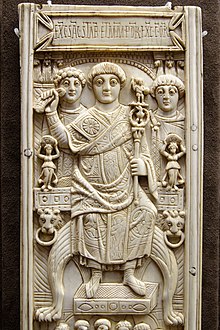

Two events were of central importance to the development of a unique, Byzantine art. Outset, the Edict of Milan, issued by the emperors Constantine I and Licinius in 313, immune for public Christian worship, and led to the development of a monumental, Christian art. Second, the dedication of Constantinople in 330 created a not bad new artistic eye for the eastern one-half of the Empire, and a specifically Christian ane. Other artistic traditions flourished in rival cities such as Alexandria, Antioch, and Rome, but it was not until all of these cities had fallen - the beginning two to the Arabs and Rome to the Goths - that Constantinople established its supremacy.
Constantine devoted great effort to the decoration of Constantinople, adorning its public spaces with ancient statuary,[xv] and building a forum dominated by a porphyry column that carried a statue of himself.[16] Major Constantinopolitan churches built under Constantine and his son, Constantius Two, included the original foundations of Hagia Sophia and the Church of the Holy Apostles.[17]
The next major building campaign in Constantinople was sponsored by Theodosius I. The most important surviving monument of this period is the obelisk and base erected by Theodosius in the Hippodrome[18] which, with the large silver dish chosen the Missorium of Theodosius I, represents the classic examples of what is sometimes chosen the "Theodosian Renaissance". The earliest surviving church in Constantinople is the Basilica of St. John at the Stoudios Monastery, built in the fifth century.[19]

Miniatures of the 6th-century Rabula Gospel (a Byzantine Syriac Gospel) display the more than abstract and symbolic nature of Byzantine art
Due to subsequent rebuilding and destruction, relatively few Constantinopolitan monuments of this early period survive. Yet, the development of monumental early on Byzantine art can nonetheless be traced through surviving structures in other cities. For example, of import early churches are found in Rome (including Santa Sabina and Santa Maria Maggiore),[twenty] and in Thessaloniki (the Rotunda and the Acheiropoietos Basilica).[21]
A number of of import illuminated manuscripts, both sacred and secular, survive from this early menstruum. Classical authors, including Virgil (represented by the Vergilius Vaticanus[22] and the Vergilius Romanus)[23] and Homer (represented by the Ambrosian Iliad), were illustrated with narrative paintings. Illuminated biblical manuscripts of this menstruum survive simply in fragments: for instance, the Quedlinburg Itala fragment is a small portion of what must have been a lavishly illustrated copy of 1 Kings.[24]
Early on Byzantine art was also marked by the cultivation of ivory etching.[25] Ivory diptychs, often elaborately decorated, were issued as gifts by newly appointed consuls.[26] Silver plates were another of import grade of luxury art:[27] among the nigh lavish from this menstruum is the Missorium of Theodosius I.[28] Sarcophagi continued to be produced in great numbers.
Age of Justinian I [edit]

Mosaic from San Vitale in Ravenna, showing the Emperor Justinian and Bishop Maximian, surrounded by clerics and soldiers.

Meaning changes in Byzantine art coincided with the reign of Justinian I (527–565). Justinian devoted much of his reign to reconquering Italy, North Africa and Spain. He too laid the foundations of the imperial authoritarianism of the Byzantine state, codifying its laws and imposing his religious views on all his subjects by law.[29]
A significant component of Justinian'south projection of purple renovation was a massive building program, which was described in a volume, the Buildings, written past Justinian'south court historian, Procopius.[30] Justinian renovated, rebuilt, or founded anew countless churches within Constantinople, including Hagia Sophia,[31] which had been destroyed during the Nika riots, the Church of the Holy Apostles,[32] and the Church of Saints Sergius and Bacchus.[33] Justinian also congenital a number of churches and fortifications outside of the imperial capital, including Saint Catherine's Monastery on Mount Sinai in Egypt,[34] Basilica of Saint Sofia in Sofia and the Basilica of St. John in Ephesus.[35]
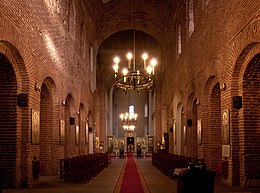
Several major churches of this period were built in the provinces past local bishops in imitation of the new Constantinopolitan foundations. The Basilica of San Vitale in Ravenna, was built past Bishop Maximianus. The decoration of San Vitale includes important mosaics of Justinian and his empress, Theodora, although neither ever visited the church.[36] Too of note is the Euphrasian Basilica in Poreč.[37]
Recent archeological discoveries in the 19th and 20th centuries unearthed a large group of Early Byzantine mosaics in the Middle East. The eastern provinces of the Eastern Roman and later the Byzantine Empires inherited a strong creative tradition from Late Antiquity. Christian mosaic art flourished in this expanse from the 4th century onwards. The tradition of making mosaics was carried on in the Umayyad era until the stop of the 8th century. The most important surviving examples are the Madaba Map, the mosaics of Mountain Nebo, Saint Catherine's Monastery and the Church of St Stephen in ancient Kastron Mefaa (at present Umm ar-Rasas).
The first fully preserved illuminated biblical manuscripts date to the commencement half of the sixth century, most notably the Vienna Genesis,[38] the Rossano Gospels,[39] and the Sinope Gospels.[40] The Vienna Dioscurides is a lavishly illustrated botanical treatise, presented as a gift to the Byzantine blueblood Julia Anicia.[41]
Of import ivory sculptures of this catamenia include the Barberini ivory, which probably depicts Justinian himself,[42] and the Archangel ivory in the British Museum.[43] Silverish plate continued to be decorated with scenes drawn from classical mythology; for example, a plate in the Cabinet des Médailles, Paris, depicts Hercules wrestling the Nemean lion.[44]
Seventh-century crisis [edit]

The Historic period of Justinian was followed past a political decline, since most of Justinian's conquests were lost and the Empire faced acute crisis with the invasions of the Avars, Slavs, Persians and Arabs in the 7th century. Constantinople was also wracked by religious and political conflict.[45]
The near meaning surviving monumental projects of this flow were undertaken outside of the regal capital. The church of Hagios Demetrios in Thessaloniki was rebuilt after a fire in the mid-seventh century. The new sections include mosaics executed in a remarkably abstract fashion.[46] The church of the Koimesis in Nicaea (present-solar day Iznik), destroyed in the early on 20th century only documented through photographs, demonstrates the simultaneous survival of a more classical style of church decoration.[47] The churches of Rome, nevertheless a Byzantine territory in this menstruum, also include important surviving decorative programs, especially Santa Maria Antiqua, Sant'Agnese fuori le mura, and the Chapel of San Venanzio in San Giovanni in Laterano.[48] Byzantine mosaicists probably also contributed to the ornament of the early on Umayyad monuments, including the Dome of the Rock in Jerusalem and the Great Mosque of Damascus.[49]
Of import works of luxury art from this period include the silver David Plates, produced during the reign of Emperor Heraclius, and depicting scenes from the life of the Hebrew king David.[l] The most notable surviving manuscripts are Syriac gospel books, such every bit the and so-called Syriac Bible of Paris.[51] All the same, the London Canon Tables bear witness to the continuing production of lavish gospel books in Greek.[52]
The menstruum between Justinian and iconoclasm saw major changes in the social and religious roles of images inside Byzantium. The veneration of acheiropoieta, or holy images "not made by human being hands," became a significant phenomenon, and in some instances these images were credited with saving cities from military assault. Past the end of the 7th century, certain images of saints had come to be viewed equally "windows" through which one could communicate with the figure depicted. Proskynesis before images is likewise attested in texts from the tardily seventh century. These developments mark the beginnings of a theology of icons.[53]
At the same fourth dimension, the debate over the proper role of art in the ornamentation of churches intensified. Three canons of the Quinisext Council of 692 addressed controversies in this area: prohibition of the representation of the cross on church pavements (Canon 73), prohibition of the representation of Christ every bit a lamb (Catechism 82), and a general injunction against "pictures, whether they are in paintings or in what way so ever, which attract the eye and corrupt the listen, and incite it to the awakening of base pleasures" (Canon 100).
Crisis of iconoclasm [edit]

Helios in his chariot, surrounded past symbols of the months and of the zodiac. From Vat. Gr. 1291, the "Handy Tables" of Ptolemy, produced during the reign of Constantine V
Intense debate over the function of art in worship led somewhen to the menses of "Byzantine iconoclasm."[54] Sporadic outbreaks of iconoclasm on the role of local bishops are attested in Asia Minor during the 720s. In 726, an underwater convulsion betwixt the islands of Thera and Therasia was interpreted by Emperor Leo III as a sign of God's anger, and may have led Leo to remove a famous icon of Christ from the Chalke Gate exterior the imperial palace.[55] However, iconoclasm probably did not get imperial policy until the reign of Leo's son, Constantine V. The Council of Hieria, convened under Constantine in 754, proscribed the manufacture of icons of Christ. This inaugurated the Iconoclastic period, which lasted, with interruptions, until 843.
While iconoclasm severely restricted the role of religious art, and led to the removal of some earlier apse mosaics and (perhaps) the desultory destruction of portable icons, it never constituted a full ban on the production of figural art. Aplenty literary sources indicate that secular art (i.due east. hunting scenes and depictions of the games in the hippodrome) connected to exist produced,[56] and the few monuments that can be securely dated to the period (most notably the manuscript of Ptolemy's "Handy Tables" today held by the Vatican[57]) demonstrate that metropolitan artists maintained a high quality of product.[58]
Major churches dating to this period include Hagia Eirene in Constantinople, which was rebuilt in the 760s following its destruction past the 740 Constantinople earthquake. The interior of Hagia Eirene, which is dominated past a large mosaic cross in the apse, is one of the best-preserved examples of iconoclastic church decoration.[59] The church building of Hagia Sophia in Thessaloniki was also rebuilt in the tardily 8th century.[60]
Certain churches built exterior of the empire during this period, but decorated in a figural, "Byzantine," style, may also acquit witness to the continuing activities of Byzantine artists. Especially important in this regard are the original mosaics of the Palatine Chapel in Aachen (since either destroyed or heavily restored) and the frescoes in the Church of Maria foris portas in Castelseprio.
Macedonian art [edit]
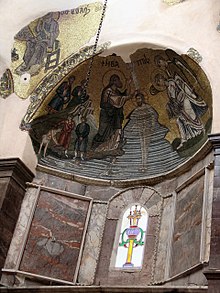
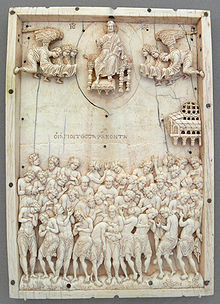
The rulings of the Council of Hieria were reversed past a new church quango in 843, celebrated to this twenty-four hour period in the Eastern Orthodox Church as the "Triumph of Orthodoxy." In 867, the installation of a new apse mosaic in Hagia Sophia depicting the Virgin and Child was celebrated by the Patriarch Photios in a famous homily as a victory over the evils of iconoclasm. After in the same year, the Emperor Basil I, called "the Macedonian," acceded to the throne; equally a issue the following period of Byzantine fine art has sometimes been called the "Macedonian Renaissance", although the term is doubly problematic (it was neither "Macedonian", nor, strictly speaking, a "Renaissance").
In the ninth and 10th centuries, the Empire's armed forces state of affairs improved, and patronage of art and compages increased. New churches were commissioned, and the standard architectural form (the "cross-in-square") and decorative scheme of the Middle Byzantine church were standardised. Major surviving examples include Hosios Loukas in Boeotia, the Daphni Monastery near Athens and Nea Moni on Chios.
There was a revival of interest in the depiction of subjects from classical Greek mythology (as on the Veroli Casket) and in the use of a "classical" Hellenistic styles to depict religious, and particularly Erstwhile Testament, subjects (of which the Paris Psalter and the Joshua Scroll are important examples).
The Macedonian period besides saw a revival of the tardily antique technique of ivory carving. Many ornate ivory triptychs and diptychs survive, such as the Harbaville Triptych and a triptych at Luton Hoo, dating from the reign of Nicephorus Phocas.
Komnenian age [edit]

The Macedonian emperors were followed by the Komnenian dynasty, beginning with the reign of Alexios I Komnenos in 1081. Byzantium had recently suffered a menstruum of severe dislocation following the Boxing of Manzikert in 1071 and the subsequent loss of Asia Modest to the Turks. All the same, the Komnenoi brought stability to the empire (1081–1185) and during the course of the twelfth century their energetic campaigning did much to restore the fortunes of the empire. The Komnenoi were groovy patrons of the arts, and with their support Byzantine artists connected to move in the direction of greater humanism and emotion, of which the Theotokos of Vladimir, the bike of mosaics at Daphni, and the murals at Nerezi yield of import examples. Ivory sculpture and other expensive mediums of art gradually gave way to frescoes and icons, which for the commencement time gained widespread popularity across the Empire. Apart from painted icons, in that location were other varieties - notably the mosaic and ceramic ones.
Some of the finest Byzantine work of this period may be found exterior the Empire: in the mosaics of Gelati, Kiev, Torcello, Venice, Monreale, Cefalù and Palermo. For instance, Venice'south Basilica of St Mark, begun in 1063, was based on the bully Church of the Holy Apostles in Constantinople, now destroyed, and is thus an echo of the historic period of Justinian. The acquisitive habits of the Venetians mean that the basilica is as well a smashing museum of Byzantine artworks of all kinds (due east.g., Pala d'Oro).
Ivory caskets of the Macedonian era (Gallery) [edit]
-
-
11th-12th century, Museo Nazionale d'Arte Medievale e Moderna (Arezzo)
Palaeologan historic period [edit]
![]()
The Annunciation from Ohrid, one of the most admired icons of the Paleologan mannerism, bears comparison with the finest contemporary works past Italian artists
Centuries of continuous Roman political tradition and Hellenistic culture underwent a crunch in 1204 with the sacking of Constantinople by the Venetian and French knights of the Fourth Crusade, a disaster from which the Empire recovered in 1261 albeit in a severely weakened state. The devastation by sack or subsequent neglect of the city's secular architecture in particular has left u.s. with an imperfect understanding of Byzantine art.
Although the Byzantines regained the city in 1261, the Empire was thereafter a modest and weak state confined to the Greek peninsula and the islands of the Aegean. During their one-half-century of exile, however, the last bully flowing of Anatolian Hellenism began. As Nicaea emerged every bit the centre of opposition nether the Laskaris emperors, information technology spawned a renaissance, alluring scholars, poets, and artists from across the Byzantine world. A glittering courtroom emerged as the dispossessed intelligentsia found in the Hellenic side of their traditions a pride and identity unsullied past association with the hated "latin" enemy.[61] With the recapture of the uppercase under the new Palaeologan Dynasty, Byzantine artists developed a new interest in landscapes and pastoral scenes, and the traditional mosaic-work (of which the Chora Church building in Constantinople is the finest extant instance) gradually gave way to detailed cycles of narrative frescoes (as evidenced in a big grouping of Mystras churches). The icons, which became a favoured medium for artistic expression, were characterized past a less ascetic attitude, new appreciation for purely decorative qualities of painting and meticulous attending to details, earning the popular proper noun of the Paleologan Mannerism for the period in general.
Venice came to command Byzantine Crete by 1212, and Byzantine artistic traditions continued long after the Ottoman conquest of the final Byzantine successor state in 1461. The Cretan school, every bit information technology is today known, gradually introduced Western elements into its style, and exported large numbers of icons to the West. The tradition'southward most famous creative person was El Greco.[62] [63]
Legacy [edit]


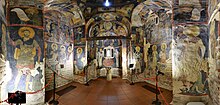
The splendour of Byzantine fine art was ever in the heed of early on medieval Western artists and patrons, and many of the about of import movements in the menstruum were conscious attempts to produce fine art fit to stand next to both classical Roman and gimmicky Byzantine fine art. This was especially the case for the majestic Carolingian art and Ottonian art. Luxury products from the Empire were highly valued, and reached for instance the imperial Anglo-Saxon Sutton Hoo burial in Suffolk of the 620s, which contains several pieces of silver. Byzantine silks were especially valued and big quantities were distributed as diplomatic gifts from Constantinople. In that location are records of Byzantine artists working in the Westward, especially during the period of iconoclasm, and some works, similar the frescos at Castelseprio and miniatures in the Vienna Coronation Gospels, seem to take been produced past such figures.
In particular, teams of mosaic artists were dispatched as diplomatic gestures by emperors to Italian republic, where they frequently trained locals to continue their work in a style heavily influenced past Byzantium. Venice and Norman Sicily were detail centres of Byzantine influence. The primeval surviving panel paintings in the West were in a way heavily influenced by contemporary Byzantine icons, until a distinctive Western way began to develop in Italy in the Trecento; the traditional and still influential narrative of Vasari and others has the story of Western painting begin as a breakaway by Cimabue and then Giotto from the shackles of the Byzantine tradition. In full general, Byzantine artistic influence on Europe was in steep decline by the 14th century if not earlier, despite the continued importance of migrated Byzantine scholars in the Renaissance in other areas.
Islamic art began with artists and craftsmen generally trained in Byzantine styles, and though figurative content was greatly reduced, Byzantine decorative styles remained a great influence on Islamic art, and Byzantine artists connected to exist imported for of import works for some time, especially for mosaics.
The Byzantine era properly defined came to an end with the fall of Constantinople to the Ottoman Turks in 1453, but past this time the Byzantine cultural heritage had been widely diffused, carried by the spread of Orthodox Christianity, to Bulgaria, Serbia, Romania and, most chiefly, to Russia, which became the centre of the Orthodox world following the Ottoman conquest of the Balkans. Even under Ottoman rule, Byzantine traditions in icon-painting and other small arts survived, specially in the Venetian-ruled Crete and Rhodes, where a "postal service-Byzantine" fashion nether increasing Western influence survived for a further two centuries, producing artists including El Greco whose training was in the Cretan School which was the most vigorous post-Byzantine school, exporting great numbers of icons to Europe. The willingness of the Cretan School to accept Western influence was atypical; in most of the mail service-Byzantine world "as an instrument of ethnic cohesiveness, art became assertively bourgeois during the Turcocratia" (catamenia of Ottoman dominion).[64]
Russian icon painting began by entirely adopting and imitating Byzantine art, every bit did the fine art of other Orthodox nations, and has remained extremely bourgeois in iconography, although its painting style has adult distinct characteristics, including influences from post-Renaissance Western art. All the Eastern Orthodox churches have remained highly protective of their traditions in terms of the form and content of images and, for example, modern Orthodox depictions of the Birth of Christ vary piffling in content from those developed in the sixth century.
See also [edit]
- Byzantine illuminated manuscripts
- Byzantine architecture
- Byzantine mosaics
- Macedonian art (Byzantine)
- Byzantine Iconoclasm
- Sacred art
- Book of Job in Byzantine Illuminated Manuscripts
Notes [edit]
- ^ Michelis 1946; Weitzmann 1981.
- ^ Kitzinger 1977, pp. 1‒3.
- ^ Michelis 1946; Ainalov 1961, "Introduction", pp. iii‒8; Stylianou & Stylianou 1985, p. 19; Hanfmann 1962, "Early Christian Sculpture", p. 42 harvnb error: no target: CITEREFHanfmann1962 (help); Weitzmann 1984.
- ^ Bassett 2004.
- ^ Cyril 1965, pp. 53‒75 harvnb error: no target: CITEREFCyril1965 (help).
- ^ Ainalov 1961, "The Hellenistic Character of Byzantine Wall Painting", pp. 185‒214.
- ^ Weitzmann 1981, p. 350.
- ^ Brendel 1979.
- ^ Berenson 1954.
- ^ Elsner 2002, pp. 358‒379.
- ^ Kitzinger 1977.
- ^ Onians 1980, pp. 1‒23.
- ^ Mango 1963, p. 65.
- ^ Belting & Jephcott 1994 harvnb mistake: no target: CITEREFBeltingJephcott1994 (help).
- ^ Bassett 2004.
- ^ Fowden 1991, pp. 119‒131; Bauer 1996.
- ^ Mathews 1971; Henck 2001, pp. 279‒304
- ^ Kiilerich 1998.
- ^ Mathews 1971.
- ^ Krautheimer 2000.
- ^ Spieser 1984; Ćurčić 2000.
- ^ Wright 1993.
- ^ Wright 2001.
- ^ Levin 1985.
- ^ Volbach 1976.
- ^ Delbrueck 1929.
- ^ Dodd 1961.
- ^ Almagro-Gorbea 2000.
- ^ Maas 2005.
- ^ Tr. H.B. Dewing, Procopius Seven (Cambridge, 1962).
- ^ Mainstone 1997.
- ^ Nighttime & Özgümüş 2002, pp. 393‒413.
- ^ Bardill 2000, pp. 1‒11; Mathews 2005.
- ^ Forsyth & Weitzmann 1973.
- ^ Thiel 2005.
- ^ Deichmann 1969.
- ^ Eufrasiana Basilica Project.
- ^ Wellesz 1960.
- ^ Cavallo 1992.
- ^ Grabar 1948.
- ^ Mazal 1998.
- ^ Cutler 1993, pp. 329‒339.
- ^ Wright 1986, pp. 75‒79.
- ^ photo of the plate
- ^ Haldon 1997.
- ^ Brubaker 2004, pp. 63‒90.
- ^ Barber 1991, pp. 43‒sixty.
- ^ Matthiae 1987.
- ^ Creswell 1969; Alluvion 2001.
- ^ Leader 2000, pp. 407‒427.
- ^ Leroy 1964.
- ^ Nordenfalk 1938.
- ^ Brubaker 1998, pp. 1215‒1254.
- ^ Bryer & Herrin 1977; Brubaker & Haldon 2001.
- ^ Stein 1980; The story of the Chalke Icon may be a later invention: Auzépy 1990, pp. 445‒492.
- ^ Grabar 1984.
- ^ Wright 1985, pp. 355‒362.
- ^ Bryer & Herrin 1977, Robin Cormack, "The Arts during the Age of Iconoclasm".
- ^ Peschlow 1977.
- ^ Theocharidou 1988.
- ^ Ash 1995.
- ^ Byron, Robert (October 1929). "Greco: The Epilogue to Byzantine Civilisation". The Burlington Magazine for Connoisseurs. 55 (319): 160–174. JSTOR 864104.
- ^ Procopiou, Angelo Grand. (March 1952). "El Greco and Cretan Painting". The Burlington Magazine. 94 (588): 76–74. JSTOR 870678.
- ^ Kessler 1988, p. 166.
References [edit]
- Ainalov, D.V. (1961). The Hellenistic Origins of Byzantine Art. New Brunswick: Rutgers University Press.
- Almagro-Gorbea, M., ed. (2000). El Disco de Teodosio. Madrid: Existent Academia de la Historia. ISBN9788489512603.
- Ash, John (1995). A Byzantine Journey . London: Random House Incorporated. ISBN9780679409342.
- Auzépy, G.-F. (1990). "La devastation de l'icône du Christ de la Chalcé par Léon Three: propagande ou réalité?". Byzantion. 60: 445‒492.
- Barber, C. (1991). "The Koimesis Church, Nicaea: The Limits of Representation on the Eve of Iconoclasm". Jahrbuch der österreichischen Byzantinistik. 41: 43‒60.
- Bardill, J. (2000). "The Church building of Sts. Sergius and Bacchus in Constantinople and the Monophysite Refugees". Dumbarton Oaks Papers. 54: 1‒eleven. doi:10.2307/1291830. JSTOR 1291830.
- Bassett, Sarah (2004). The Urban Paradigm of Late Antique Constantinople. Cambridge: Cambridge University Press. ISBN9780521827232.
- Bauer, Franz Alto (1996). Stadt, Platz und Denkmal in der Spätantike. Mainz: P. von Zabern. ISBN9783805318426.
- Belting, Hans; Jephcott (tr.), Edmund (1994). Likeness and Presence: A History of the Epitome before the Era of Art. Chicago: Chicago University Press. ISBN9780226042152.
- Berenson, Bernard (1954). The Arch of Constantine, or, the Decline of Form. London: Chapman and Hall.
- Brendel, Otto J. (1979). Prolegomena to the Written report of Roman Art . New Haven: Yale Academy Printing. ISBN9780300022681.
- Brubaker, Leslie; Haldon, John (2001). Byzantium in the Iconoclast Era (ca. 680-850): The Sources. Birmingham: Ashgate.
- Brubaker, L. (1998). "Icons before iconoclasm?, Morfologie sociali east culturali in europa fra tarda antichita e alto medioevo". Settimane di Studio del Centro Italiano di Studi Sull' Alto Medioevo. 45: 1215‒1254.
- Brubaker, Fifty. (2004). "Elites and Patronage in Early Byzantium: The Prove from Hagios Demetrios in Thessalonike". In Haldon, John; et al. (eds.). The Byzantine and Early Islamic Nearly East: Elites Old and New. Princeton: Princeton University Press. pp. 63‒90.
- Bryer, A.; Herrin, Judith, eds. (1977). Iconoclasm: Papers Given at the Ninth Jump Symposium of Byzantine Studies, University of Birmingham, March 1975. Birmingham: Center for Byzantine Studies. ISBN9780704402263.
- Cavallo, Guglielmo (1992). Il codex purpureus rossanensis. Rome.
- Creswell, Keppel A.C. (1969). Early Muslim Compages. New York: Clarendon Press.
- Ćurčić, Slobodan (2000). Some Observations and Questions Regarding Early Christian Architecture in Thessaloniki. Thessaloniki: Υπουργείον Πολιτισμού: Εφορεία Βυζαντινών Αρχαιοτήτων Θεσσαλονίκης. ISBN9789608674905.
- Cutler, A. (1993). "Barberiniana: Notes on the Making, Content, and Provenance of Louvre OA. 9063". Tesserae: Festschrift für Josef Engemann, Jahrbuch für Antike und Christentum, Ergänzungsband. 18: 329‒339.
- Night, K.; Özgümüş, F. (2002). "New Prove for the Byzantine Church of the Holy Apostles from Fatih Camii, Istanbul". Oxford Journal of Archaeology. 21 (4): 393‒413. doi:10.1111/1468-0092.00170.
- Deichmann, Friedrich Wilhelm (1969). Ravenna: Hauptstadt des spätantiken Abendlandes. Wiesbaden: Franz Steiner. ISBN9783515020053.
- Delbrueck, R. (1929). Die Consulardiptychen und Verwandte Denkmäler. Berlin: De Gruyter.
- Dodd, Erica Cruikshank (1961). Byzantine Silvery Stamps. Washington: Dumbarton Oaks Research Library and Collection, Trustees for Harvard University.
- Elsner, J. (2002). "The Nascency of Late Antiquity: Riegl and Strzygowski in 1901". Art History. 25 (iii): 358‒379. doi:10.1111/1467-8365.00326.
- Ene D-Vasilescu, Elena (2021). Michelangelo, the Byzantines, and Plato. ISBN9781800498792.
- Ene D-Vasilescu, Elena (2021). Glimpses into Byzantium. Its Philosophy and Arts. ISBN9781800498808.
- Inundation, Finbarr Barry (2001). The Great Mosque of Damascus: Studies on the Making of an Umayyad Visual Culture. Leiden: Brill.
- Forsyth, George H.; Weitzmann, Kurt (1973). The Monastery of St. Catherine at Mount Sinai: The Church and Fortress of Justinian. Ann Arbor: University of Michigan Press.
- Fowden, Garth (1991). "Constantine's Porphyry Column: The Primeval Literary Allusion". Journal of Roman Studies. 81: 119‒131. doi:ten.2307/300493. JSTOR 300493.
- Grabar, André (1984). 50'iconoclasme byzantin: Le dossier archéologique (2nd ed.). Paris: Flammarion. ISBN9782080126030.
- Grabar, André (1948). Les peintures de 50'évangéliaire de Sinope (Bibliothèque nationale, Suppl. gr. 1286). Paris: Bibliothèque nationale.
- Haldon, John (1997) [1990]. Byzantium in the Seventh Century: The Transformation of a Culture. Cambridge: Cambridge University Press.
- Hanfmann, George Maxim Anossov (1967). Classical Sculpture. Greenwich, CT: New York Graphic Society.
- Henck, North. (2001). "Constantius ho Philoktistes?" (PDF). Dumbarton Oaks Papers. 55: 279‒304. doi:10.2307/1291822. JSTOR 1291822. Archived from the original (PDF) on 2014-05-12. Retrieved 2014-09-29 .
- Kessler, Herbert Fifty. (1988). "On the State of Medieval Fine art History". The Art Bulletin. 70 (2): 166–187. doi:ten.1080/00043079.1988.10788561. JSTOR 3051115.
- Kiilerich, Bente (1998). The Obelisk Base in Constantinople. Rome: G. Bretschneider.
- Kitzinger, Ernst (1977). Byzantine Art in the Making: Main Lines of Stylistic Evolution in Mediterranean Fine art, 3rd‒7th Century. Cambridge: Cambridge University Press. ISBN978-0571111541.
- Krautheimer, R. (2000). Rome: Contour of a City. Princeton: Princeton University Press. ISBN9780691049618.
- Leader, R. (2000). "The David Plates Revisited: Transforming the Secular in Early Byzantium". Art Message. 82 (iii): 407‒427. doi:x.2307/3051395. JSTOR 3051395.
- Leroy, Jules (1964). Les manuscrits syriaques à peintures conservés dans les bibliothèques d'Europe et d'Orient; contribution à l'étude de l'iconographie des Églises de langue syriaque. Paris: Librairie orientaliste P. Geuthner.
- Levin, I. (1985). The Quedlinburg Itala: The Oldest Illustrated Biblical Manuscript. Leiden: E.J. Brill. ISBN9789004070936.
- Maas, M., ed. (2005). The Cambridge Companion to the Age of Justinian. Cambridge: Cambridge University Press. ISBN9781139826877.
- Mainstone, Rowland J. (1997). Hagia Sophia: Architecture, Structure, and Liturgy of Justinian's Keen Church. New York: Thames and Hudson. ISBN9780500279458.
- Mango, Cyril (1963). "Antique Statuary and the Byzantine Beholder". Dumbarton Oaks Papers. 17: 53‒75. doi:10.2307/1291190. JSTOR 1291190.
- Mathews, Thomas F. (1971). The Early on Churches of Constantinople: Architecture and Liturgy. University Park: Pennsylvania State Academy Printing. ISBN9780271001081.
- Mathews, Thomas F. (2005). "The Palace Church of Sts. Sergius and Bacchus in Constantinople". In Emerick, J.J.; Delliyannis, D.M. (eds.). Archaeology in Compages: Studies in Honor of Cecil Fifty. Striker. Mainz: von Zabern. ISBN9783805334921.
- Matthiae, Guglielmo (1987). Pittura romana del medioevo. Rome: Fratelli Palombi. ISBN9788876212345.
- Mazal, Otto (1998). Der Wiener Dioskurides: Codex medicus Graecus 1 der Österreichischen Nationalbibliothek. Graz: Akademische Druck u. Verlagsanstalt. ISBN9783201016995.
- Michelis, Panayotis A. (1946). An Aesthetic Approach to Byzantine Art. Athens.
- Nordenfalk, Carl (1938). Dice spätantiken Kanontafeln. Göteborg: O. Isacsons boktryckeri a.-b.
- Onians, J. (1980). "Abstraction and Imagination in Tardily Artifact". Art History. iii: 1‒23. doi:10.1111/j.1467-8365.1980.tb00061.x.
- Peschlow, Urs (1977). Die Irenenkirche in Istanbul. Tübingen: E. Wasmuth. ISBN9783803017178.
- Runciman, Steven (1987) [1954]. A History of the Crusades: The Kingdom of Acre and the Subsequently Crusades. Cambridge: Cambridge University Press. ISBN978-0521347723.
- Spieser, J.-M. (1984). Thessalonique et ses monuments du IVe au VIe siècle. Athens: Ecole française d'Athènes.
- Stein, D. (1980). Der Beginn des byzantinischen Bilderstreites und seine Entwicklung bis in die 40er Jahre des 8. Jahrhunderts. Munich: Institut für Byzantinistik und Neugriechische Philologie der Universität.
- Stylianou, Andreas; Stylianou, Judith A. (1985). The Painted Churches of Cyprus: Treasures of Byzantine Art. London: Trigraph for the A.K. Leventis Foundation.
- Theocharidou, 1000. (1988). The Architecture of Hagia Sophia, Thessaloniki, from its Erection up to the Turkish Conquest. Oxford: Oxford University Printing.
- Thiel, Andreas (2005). Die Johanneskirche in Ephesos. Wiesbaden: Isd. ISBN9783895003547.
- Volbach, Wolfgang Fritz (1976). Elfenbeinarbeiten der Spätantike und des frühen Mittelalters. Mainz: von Zabern. ISBN9783805302807.
- Weitzmann, Kurt (1981). Classical Heritage in Byzantine and Near Eastern Art. London: Variorum Reprints.
- Weitzmann, Kurt (1984). Greek Mythology in Byzantine Art. Princeton: Princeton University Press. ISBN9780860780878.
- Wellesz, Emmy (1960). The Vienna Genesis. London: T. Yoseloff.
- Wright, D. H. (1985). "The Date of the Vatican Illuminated Handy Tables of Ptolemy and of its Early on Additions". Byzantinische Zeitschrift. 78 (ii): 355‒362. doi:10.1515/byzs.1985.78.2.355. S2CID 194111177.
- Wright, D. (1986). "Justinian and an Archangel". Studien zur Spätantiken Kunst Friedrich Wilhelm Deichmann Gewidmet. Mainz. III: 75‒79.
- Wright, David Herndon (2001). The Roman Vergil and the Origins of Medieval Book Design. Toronto: Academy of Toronto Printing. ISBN9780802048196.
- Wright, David Herndon (1993). The Vatican Vergil: A Masterpiece of Late Antique Art. Berkeley: University of California Press. ISBN9780520072404.
Further reading [edit]
- Alloa, Emmanuel (2013). "Visual Studies in Byzantium". Periodical of Visual Civilisation. 12 (1): 3‒29. doi:10.1177/1470412912468704. S2CID 191395643.
- Beckwith, John (1979). Early Christian and Byzantine Art (2nd ed.). Penguin History of Fine art. ISBN978-0140560336.
- Cormack, Robin (2000). Byzantine Fine art . Oxford: Oxford University Press. ISBN978-0-19-284211-four.
- Cormack, Robin (1985). Writing in Gold, Byzantine Guild and its Icons. London: George Philip. ISBN978-054001085-1.
- Eastmond, Antony (2013). The Celebrity of Byzantium and Early Christendom. London: Phaidon Printing. ISBN978-0714848105.
- Evans, Helen C., ed. (2004). Byzantium, Organized religion and Power (1261‒1557) . Metropolitan Museum of Fine art/Yale Academy Printing. ISBN978-1588391148.
- Evans, Helen C. & Wixom, William D. (1997). The Celebrity of Byzantium: Art and Culture of the Middle Byzantine Era, A.D. 843‒1261. New York: The Metropolitan Museum of Art. OCLC 853250638.
- Hurst, Ellen (8 Baronial 2014). "A Beginner's Guide to Byzantine Art". Smarthistory. Retrieved 20 Apr 2016.
- James, Elizabeth (2007). Art and Text in Byzantine Civilisation (1 ed.). Cambridge: Cambridge University Printing. ISBN978-0-521-83409-4.
- Karahan, Anne (2015). "Patristics and Byzantine Meta-Images. Molding Belief in the Divine from Written to Painted Theology". In Harrison, Ballad; Bitton-Ashkelony, Brouria; De Bruyn, Théodore (eds.). Patristic Studies in the Twenty-First Century. Turnhout: Brepols Publishers. pp. 551–576. ISBN978-2-503-55919-iii.
- Karahan, Anne (2010). Byzantine Holy Images – Transcendence and Immanence. The Theological Background of the Iconography and Aesthetics of the Chora Church (Orientalia Lovaniensia Analecta No. 176). Leuven-Paris-Walpole, MA: Peeters Publishers. ISBN978-90-429-2080-4.
- Karahan, Anne (2016). "Byzantine Visual Culture. Conditions of "Right" Belief and some Platonic Outlooks"". Numen: International Review for the History of Religions. Leiden: Koninklijke Brill NV. 63 (2–iii): 210–244. doi:10.1163/15685276-12341421. ISSN 0029-5973.
- Karahan, Anne (2014). "Byzantine Iconoclasm: Ideology and Quest for Power". In Kolrud, K.; Prusac, Thousand. (eds.). Iconoclasm from Antiquity to Modernity. Farnham Surrey: Ashgate Publishing Ltd. pp. 75‒94. ISBN978-ane-4094-7033-5.
- Karahan, Anne (2015). "Chapter 10: The Impact of Cappadocian Theology on Byzantine Aesthetics: Gregory of Nazianzus on the Unity and Singularity of Christ". In Dumitraşcu, N. (ed.). The Ecumenical Legacy of the Cappadocians. New York, NY: Palgrave Macmillan. pp. 159‒184. ISBN978-one-137-51394-6.
- Karahan, Anne (2012). "Beauty in the Optics of God. Byzantine Aesthetics and Basil of Caesarea". Byzantion: Revue Internationale des Études Byzantines. 82: 165‒212. eISSN 2294-6209. ISSN 0378-2506. *Karahan, Anne (2013). "The Image of God in Byzantine Cappadocia and the Issue of Supreme Transcendence". Studia Patristica. 59: 97‒111. ISBN978-90-429-2992-0.
- Karahan, Anne (2010). "The Consequence of περιχώρησις in Byzantine Holy Images". Studia Patristica. 44: 27‒34. ISBN978-90-429-2370-6.
- Gerstel, Sharon E. J.; Lauffenburger, Julie A., eds. (2001). A Lost Art Rediscovered. Pennsylvania State University. ISBN978-0-271-02139-three.
- Mango, Cyril, ed. (1972). The Art of the Byzantine Empire, 312‒1453: Sources and Documents. Englewood Cliffs.
- Obolensky, Dimitri (1974) [1971]. The Byzantine Democracy: Eastern Europe, 500‒1453. London: Cardinal. ISBN9780351176449.
- http://www.biblionet.gr/book/178713/Ανδρέου,_Ευάγγελος/Γεώργιος_Μάρκου_ο_ΑργείοςWeitzmann, Kurt, ed. (1979). Age of Spirituality: Late Antique and Early Christian Fine art, Tertiary to Seventh Century. New York: The Metropolitan Museum of Art.
External links [edit]
- Byzantine Publications Online, freely available for download from Dumbarton Oaks
- Lethaby, William (1911). . Encyclopædia Britannica. Vol. 4 (11th ed.). pp. 906–911.
- Eikonografos.com: Byzantine Icons and Mosaics Archived 2012-03-31 at the Wayback Car
- Anthony Cutler on the economic history of Byzantine mosaics, wall-paintings and icons at Dumbarton Oaks.
- http://www.biblionet.gr/book/178713/Ανδρέου,_Ευάγγελος/Γεώργιος_Μάρκου_ο_Αργείος
rodriguezwasuacts.blogspot.com
Source: https://en.wikipedia.org/wiki/Byzantine_art


0 Response to "Byzantine Art Seated Dog Byzantine Art Seated Dog Mosaic Wiki"
Post a Comment